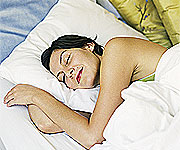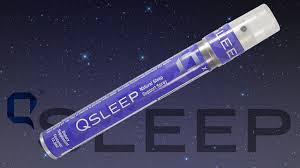Melatonin
New Research Shows Impressive Health Benefits By Debra Fulghum Bruce, PhD

New research indicates that melatonin does much more than help people sleep better. Exciting studies show that melatonin’s multifacited effects may improve treatment outcomes in cancer patients and extend their lives. Additional applications of melatonin include guarding the nervous system against degenerative diseases – such as Alzheimer’s disease and stroke – and preventing debilitating migraines.
Melatonin is secreted from the pineal gland deep inside the brain. For more than a quarter-century, scientists have been intrigued by melatonin’s ability to coordinate the body’s physiological rhythms that help set the brain’s biological clock.
The principal factor affecting melatonin is light, which inhibits the secretion of this hormone. Darkness has the opposite effect from light, resulting in signaling the pineal gland to increase melatonin secretion. The normal cycles of melatonin production are altered due to factors including aging, medications, and light exposure at night. While the long-term health effects of disrupted melatonin secretion are not yet fully known, some scientists have suggested that years of working nights could lead to adverse effects – even cancer.
Fortunately, melatonin supplements can safely and effectively restore balance to the body’s circadian rhythm of this important hormone – helping achieve a restful night’s sleep and keeping your biological clock ticking throughout a long, healthy life span.
Neuroprotective Benefits
Melatonin is a powerful and versatile antioxidant produced within the body. Melatonin protects both lipids and proteins against damage, and can scavenge some of the most dangerous free radical in the body – including hydroxyl radicals and hydrogen peroxide. Unlike other antioxidants, melatonin easily diffuses into all cells, and even crosses the blood-brain barrier to protect the delicate brain. 1
Unfortunately, levels of naturally produced melatonin decline with advancing age, leaving older adults with unlimited antioxidant protection against conditions associated with oxidative stress, particularly neurodegenerative diseases. 1 Supplementing with melatonin may thus help older adults enhance their antioxidant protection against some of the most ravaging diseases of aging, such as Alzheimer’s disease, Parkinson’s disease, and stroke.
Melatonin levels are particularily low in patients with Alzheimer’s disease. Nearly half of affected individuals suffer from sleep disturbances and “sundowning” – increased confusion, agitation, and other symptoms in the afternoon and evening. 2Not surprisingly, melatonin supplementation benefits patients with Alzheimer’s disease by providing sleep and reducing late-day aggravation of symptoms. Melatonin has also been found to decrease cognitive deterioration in individuals with Alzheimer’s disease, possibly by protecting brain cells from the toxic protein, beta-amyloid. 2

Melatonin may likewise play an important role in assisting patients suffering from Parkinson’s disease. Parkinson’s disease is associated with the disrupted melatonin secretion in the brain, and supplemental melatonin may help improve sleep efficiency in affected adults. 3 The brain can suffer dramatic, irreparable damage when an individual suffers a stroke. Utilizing animal models of stroke, scientists have found that melatonin may offer important protection against stroke-related damage and deterioration. When administered at the time of stroke, melatonin limited the area of brain tissue damage, decreased brain cell death, lessened behavioral deficits, and reduced the rate of stroke-related death. These investigators believe that melatonin’s protective actions stem from it’s free-radical-scavenging and antioxidant activities, and suggest that melatonin may hold promise in improving stroke outcomes in humans. 4
Melatonin may help manage one of the leading risk factors for stroke – elevated blood pressure. While an earlier study reported that hypertensive men taking melatonin experiences reduced nighttime blood pressure, a newer study confirms the same benefit for women. 5 In a randomized, double-blind study, 18 women (aged 47 to 63) with either normal blood pressure or treated high blood pressure received a three-week course of slow release melatonin (3mg) or placebo, one hour before bedtime. Researchers recorded blood pressure readings for 41 hours at the end of the trial. While the daytime blood pressure readings remained unchanged compared to placebo, the melatonin treatment significantly drecreased nighttime blood pressure, without modifying heart rate. 6
Fighting Cancer
One of melatonin’s most important applications is in fighting a wide array of cancers, including breast and liver cancers, non-small-cell lung cancer, and brain metastases from solid tumors. 7
When women with metastatic breast cancer who had failed to respond to tamoxifen received melatonin supplements (20mg every evening), they demonstrated an improved response to the chemotherapy drug. more than one quarter of the subjects – whose disease otherwise was expected to progress rapidly – began responding to the chemotherapy treatment. Most of the women also experienced anxiety relief from the melatonin supplementation. 8 Laboratory studies suggest that melatonin may help fight hormone-responsive breast cancers by inhibiting the aromatase enzyme, which is responsible for the local synthesis of estrogens. 9,10
Emerging research suggests that melatonin may help fight one of the most common malignancies in aging men – prostrate cancer. In the laboratory, scientists treated androgen-sensitive and androgen-intensive prostate cancer cells with pharmacological concentrations of melatonin. Treatment with melatonin dramatically reduced the number of prostrate cancer cells, while the remaining cells displayed signs of slowed replication and increased differentiation – characteristics of healthy, non-cancerous cells. Melatonin may thus hold promise against prostrate cancers, whether they are hormone-sensitive of hormone-insentive. 11
Scientists conducted a meta-analysis of 10 randomized, controlled trials examining melatonin’s effects (alone or as an adjuvant treatment) on patients with various types of cancer. Supplementation with melatonin reduced the relative risk of death at one year by an impressive 34% – regardless of the type of cancer or the melatonin dosage. Importantly, no adverse effects were reported. 12
In addition to it’s benefits for cancer survival, melatonin may also help counteract the toxicity of chemotherapy treatment. Two-hundred-fifty individuals undergoing chemotherapy for advanced cancers of the lung, breast, gastrointestinal tract, or head and neck received chemotherapy, either alone or in combination with melatonin (20 mg/day). After one year, the melatonin-supplemented individuals demonstrated a higher rate of survival, and were significantly protected against many or the side effects associated with chemotherapy, including decreased platelet count, neurotoxicity, heart damage, mouth sores, and fatigue. 13
Migraine Prevention
 A promising study suggests that a migraine sufferers may be able to reduce the frequency and severity of their headaches by using melatonin. Researchers gave 34 migraine sufferers (29 women and 5 men) a 3-mg dose of melatonin, 30 minutes before bedtime, for three months. Of the 32 patients who finished the study, more than two thirds experienced at least a 50% reduction in number of headaches per month. Additionally, the intensity and duration of headaches decreased. The scientists believe that melatonin’s anti-inflammatory effect and free-radical-scavenging effects contribute to its headache-relieving benefits. 14
A promising study suggests that a migraine sufferers may be able to reduce the frequency and severity of their headaches by using melatonin. Researchers gave 34 migraine sufferers (29 women and 5 men) a 3-mg dose of melatonin, 30 minutes before bedtime, for three months. Of the 32 patients who finished the study, more than two thirds experienced at least a 50% reduction in number of headaches per month. Additionally, the intensity and duration of headaches decreased. The scientists believe that melatonin’s anti-inflammatory effect and free-radical-scavenging effects contribute to its headache-relieving benefits. 14
Promoting Healthy Sleep
 Obtaining sufficient amounts of quality sleep is an absolute necessity of good health, yet many of us experience sleep difficulties on occasion. Insomnia occurs due to a variety of factors – ranging from long hours of work or travel to sleep-disruptive conditions, such as urinary frequency and stressful events. Elderly adults may be particularly susceptible to difficult sleeping and nighttime awakenings, due to the decline in melatonin levels associated with aging. 15 Melatonin can help promote healthy sleep patterns in some people, regardless of the cause of insomnia.
Obtaining sufficient amounts of quality sleep is an absolute necessity of good health, yet many of us experience sleep difficulties on occasion. Insomnia occurs due to a variety of factors – ranging from long hours of work or travel to sleep-disruptive conditions, such as urinary frequency and stressful events. Elderly adults may be particularly susceptible to difficult sleeping and nighttime awakenings, due to the decline in melatonin levels associated with aging. 15 Melatonin can help promote healthy sleep patterns in some people, regardless of the cause of insomnia.
A large analysis revealed several of melatonin’s sleep-enhancing benefits. Reviewing 15 studies of sleep in healthy adults, scientists noted that melatonin administration significantly reduced sleep latency (the amount of time needed to fall asleep), while boosting sleep efficiency (the percentage of time in bed spent asleep) and increasing total sleep duration. 16
Men with benign prostatic enlargement often experience poor sleep due to nighttime urinary frequency. Scientists from the United Kingdom found that melatonin may offer an effective solution. When 20 older men were treated with 2mg of melatonin each day for one month, they experienced a significant decrease in nighttime urination, and reported that their condition was less bothersome than before treatment. 15
Individuals who work the night shift are often chronically tired due to difficulty falling asleep during the daytime. Supplementing with melatonin has helped improve the length and quality of daytime sleep in these individuals. These findings demonstrate an important characteristic of melatonin: the hormone exerts its hypnotic (sleep-inducing) and sedative (anxiety-relieving) effects, regardless of dosage time. 7
Traveling to different time zones often leads to the fatigue and insomnia known as jet lag. Supplementing with melatonin can help prevent or reduce jet lag, particularly when traveling across several time zones. Melatonin works by helping re-synchronize the body’s circadian rhythms, helping the traveler adapt to the local time. 7
Dosage and Interactions
Melatonin is used in doses ranging from 0.3 – 5.0 mg to promote sleep, with doses of 1 – 3 mg most common. 17 Studies examing melatonin’s effects on cancer have utilized doses of 3 – 50 mg/day. 7
Melatonin has a sedating effect, which may be magnified by the use of benzodiazepines or other sedating drugs such as antihistamines or antidepressants. Similarly, the use of melatonin with valerian, 5-hydroxytryptophan, or alcohol may increase sedation. 17
The bioavailability of oral melatonin is increased by co-administration of the antidepressant drug fluvoxamine (Luvox®). 17 Beta blockers, as well as asprin and other non-steroidal anti-inflammatory drugs, may decrease melatonin production in the body. 17
NEW FROM Q SCIENCES
 QSleep contains 1.0 mg of melatonin per serving. This specifically proportioned amount of melatonin is gentle enough to not raise melatonin levels in the body higher than are naturally produced when the pineal gland is functioning properly, but sufficient to aid in restful sleep. QSleep also contains 0.75 mg of 5-HTP per serving. 5-HTP (5-Hydroxytryptophan) is a chemical by-product of the protein building block L-tryptophan. It works in the brain and central nervous system to increase the production of serotonin, which affects sleep.
QSleep contains 1.0 mg of melatonin per serving. This specifically proportioned amount of melatonin is gentle enough to not raise melatonin levels in the body higher than are naturally produced when the pineal gland is functioning properly, but sufficient to aid in restful sleep. QSleep also contains 0.75 mg of 5-HTP per serving. 5-HTP (5-Hydroxytryptophan) is a chemical by-product of the protein building block L-tryptophan. It works in the brain and central nervous system to increase the production of serotonin, which affects sleep.
In addition to these three main ingredients, QSleep contains a proprietary herbal extract to help a person stay asleep throughout the night. The proprietary extract includes the following:
Cramp bark: The chemicals in cramp bark seem to decrease muscle spasms. These chemicals may also lower blood pressure and decrease heart rate.*
 Feverfew: The feverfew herb has many uses, but it seems to be effective for preventing migraine headaches, which can interfere with sleep.*
Feverfew: The feverfew herb has many uses, but it seems to be effective for preventing migraine headaches, which can interfere with sleep.*
Ginkgo biloba: Ginkgo biloba leaves are generally used to make extracts that improve blood circulation, which might help the brain, eyes, ears, and legs function better.*
Passionflower: The passionflower is a plant often used for insomnia, gastrointestinal (GI) upset related to anxiety or nervousness, generalized anxiety disorder (GAD), and relieving symptoms related to narcotic drug withdrawal. The chemicals in passionflower have been used for calming, sleep inducing, and muscle spasm relieving effects.
Peppermint: Studies have shown that the leaf and oil from the Peppermint plant provide numerous health benefits. It may aid in helping relieve muscle pain, nerve pain, digestive processes, upset stomach, and inflammation.
Skullcap: Although used for many conditions, there is not yet enough scientific evidence to determine whether or not Skullcap is effective for any one condition. Most commonly, skullcap is used for trouble sleeping, anxiety, stroke, and spasms.
Valerian root: Valerian is an herb that has been used for centuries to help with anxiety and act as a sleep aid. It comes from the valerian plant and works particularly well when combined with other herbs including passionflower.
QSleep is a safe, gentle formula that works in tandem with Qssentials by helping your body and mind regenerate properly throughout the night, thus functioning optimally during the daytime hours. The oral spray delivery method works quickly and may be used as needed.
Each tube contains approximately 30 servings.
Recommended Use: Shake gently and spray 6 to 8 times directly into mouth 15 minutes before going to bed.
You can order Q Sleep here at http://q4mentalhealth.myqxlife.com or click on image.
* The statements made on this website have not been evaluated by the FDA. This product is not intended to diagnose, treat, cure, or prevent any disease. The information presented on this site is not a substitution for professional healthcare advice. Always consult your doctor or healthcare practitioner for questions or guidance on medical problems and conditions.
Conclusion
 A factor in restorative sleep, melatonin’s benefits extend to neuroprotection and fighting cancer. Its powerful antioxidant effect offers important enhancements to the brain and nervous system, helping protect against age-related damage. Most exciting are melatonin’s benefits for cancer patients – relieving anxiety and improving survival from an array of cancers. Finally, migraine sufferers using melatonin may enjoy a vast decline in the frequency and severity of their headaches – leading to a tremendously improved quality of life.
A factor in restorative sleep, melatonin’s benefits extend to neuroprotection and fighting cancer. Its powerful antioxidant effect offers important enhancements to the brain and nervous system, helping protect against age-related damage. Most exciting are melatonin’s benefits for cancer patients – relieving anxiety and improving survival from an array of cancers. Finally, migraine sufferers using melatonin may enjoy a vast decline in the frequency and severity of their headaches – leading to a tremendously improved quality of life.
References
1. Suzen S. Recent developments of melatonin related antioxidant compounds. Comb Chem High Throughput Screen. 2006 Jul;9(6):409-19.
2. Cardinali DP, Furio AM, Reyes MP. Clinical perspectives for the use of melatonin as a chronobiotic and cytoprotective agent. Ann NY Acad Sci. 2005 Dec;1057:327-36.
3. Srinivasan V, Pandi-Perumal S, Cardinali D, Poeggeler B, Hardeland R. Melatonin in Alzheimer’s disease and other neurodegenerative disorders. Behav Brain Funct. 2006;2(1):15.
4. Reiter RJ, Tan DX, Leon J, Kilic U, Kilic E. When melatonin gets on your nerves: its beneficial actions in experimental models of stroke. Exp Biol Med (Maywood.). 2005 Feb;230(2):104-17.
5. Scheer FA, Van Montfrans GA, van Someren EJ, Mairuhu G, Buijs RM. Daily nighttime melatonin reduces blood pressure in male patients with essential hypertension. Hypertension. 2004 Feb;43(2):192-7.
6. Cagnacci A, Cannoletta M, Renzi A, et al. Prolonged melatonin administration decreases nocturnal blood pressure in women. Am J Hypertens. 2005 Dec;18(12 Pt 1):1614-8.
7. [No authors listed] Melatonin. Monograph. Altern Med Rev. 2005 Dec;10(4):326-36.
8. Lissoni P, Barni S, Meregalli S, et al. Modulation of cancer endocrine therapy by melatonin: a phase II study of tamoxifen plus melatonin in metastatic breast cancer patients progressing under tamoxifen alone. Br J Cancer.1995 Apr;71(4):854-6.
9. Cos S, Gonzalez A, Martinez-Campa C, et al. Estrogen-signaling pathway: a link between breast cancer and melatonin oncostatic actions. Cancer Detect Prev. 2006;30(2):118-28.
10. Sanchez-Barcelo EJ, Cos S, Mediavilla D, et al. Melatonin-estrogen interactions in breast cancer. J Pineal Res. 2005 May;38(4):217-22.
11. Sainz RM, Mayo JC, Tan DX, Leon J, Manchester L, Reiter RJ. Melatonin reduces prostate cancer cell growth leading to neuroendocrine differentiation via a receptor and PKA independent mechanism. Prostate. 2005 Apr 1;63(1):29-43.
12. Mills E, Wu P, Seely D, Guyatt G. Melatonin in the treatment of cancer: a systematic review of randomized controlled trials and meta-analysis. J Pineal Res. 2005 Nov;39(4):360-6.
13. Lissoni P, Barni S, Mandala M, et al. Decreased toxicity and increased efficacy of cancer chemotherapy using the pineal hormone melatonin in metastatic solid tumour patients with poor clinical status. Eur J Cancer. 1999 Nov;35(12):1688-92.
14. Peres MF, Zukerman E, da Cunha TF, Moreira FR, Cipolla-Neto J. Melatonin, 3 mg, is effective for migraine prevention. Neurology. 2004 Aug 24;63(4):757.
15. Drake MJ, Mills IW, Noble JG. Melatonin pharmacotherapy for nocturia in men with benign prostatic enlargement. J Urol. 2004 Mar;171(3):1199-202.
16. Brzezinski A, Vangel MG, Wurtman RJ, et al. Effects of exogenous melatonin on sleep: a meta-analysis. Sleep Med Rev. 2005 Feb;9(1):41-50.
17. Available at: http://www.pdrhealth.com/drug_info/nmdrugprofiles/nutsupdrugs/mel_0286.shtml. Accessed March 16, 2007.
 EMPowerplus Q96™ Proven Effective:
EMPowerplus Q96™ Proven Effective:





















You must be logged in to post a comment.